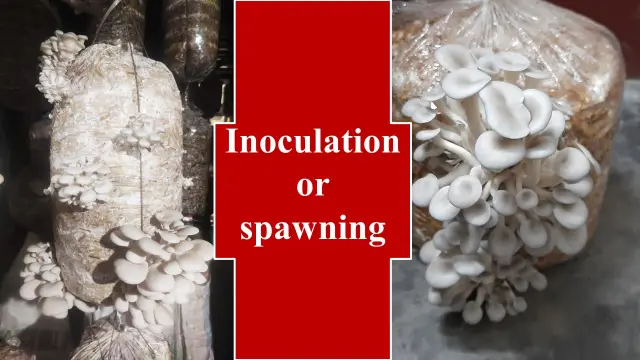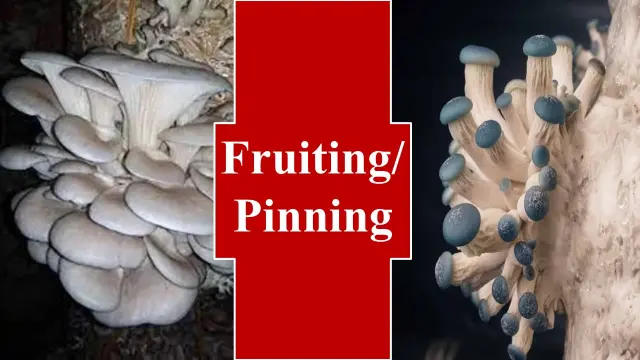With velvet-like soft caps looking like a hat curled at the edges and topped on a delicate stem, turning decay into life, oyster mushrooms or Pleurotus sp. are placed on the list of the most delicious culinary fungi. In alluring hues of white, pink, gray and many more, they exhibit resilience and adaptations. Places where vegetation can’t be thought of, oyster mushrooms will exhibit their existence, they’re found on coffee grounds, wooden logs etc.
It’s a perfect substitute for people who want a meaty texture in their food but don’t want to consume meat and are curious about how to grow oyster mushrooms at home in India or anywhere worldwide. Blessed is the soil which has mushrooms in its vicinity, wondering how !! Through their hyphal tips they release enzymes that break down organic matter and enrich the soil which is why they’re also famous as fungal decomposers.
Types of commonly grown mushrooms in India
- Oyster Mushrooms
- Button mushrooms
- Shiitake mushrooms
- Flammulina filiformis
- Portobello mushrooms
- Lion’s mane
- Shimeji mushrooms
- Also Read – 6 Most Important Types of Mushroom in India
Before we get through the process about how to grow oyster mushrooms at home in India, let’s get familiarized with some terminologies:-
Spawn
Spawn acts like a seed to mushroom & carries strain of specific mushroom variety or species which when cultivated, develops into successive stages of growth to finally become a full grown mushroom ready to pluck. They’re usually available in the market but can also be prepared at home and are of different types according to the medium they’re prepared in like sawdust spawn, plug spawn, grain spawn etc.
Pasteurisation
Abortion of harmful microbes is an important step in growing mushrooms and not letting the beneficial ones die is a responsibility during the process. Pasteurisation does the same. It can be done through steam, hot water and biologically (through fermentation). Mushrooms grow on substrate which is susceptible to contamination which calls for the need of pasteurisation of substrate.
Usually basic steps of cultivation of almost every type of mushroom are the same, so knowing how to grow oyster mushrooms at home in India isn’t as complicated as it is thought to be. Substrate, spawn, dark room, moisture etc. are some basic requirements in the process.
Steps to Grow oyster mushrooms at Home
1. Site selection
Mushrooms require warm and humid conditions to colonise, a typical feature of fungus. You have to be meticulous about their growing sites. A well lit shady place with no sunlight penetration, humidity and good aeration is ideal for mushroom cultivation. Use of air conditioners, heaters and other control systems is also done to maintain the temperature. Humidity requirement for oyster mushrooms – 80-95 Temperature requirement for oyster mushrooms – 60-75°FAlthough they don’t photosynthesise and therefore don’t need heavy or high intensity light, there are still some growth stages like primordia formation that ask for low to moderator light which is at times provided with LED light systems. Please make sure to provide even light distribution otherwise uneven growth is observed. CO2 levels must also be checked as they cause growth inhibition in mushrooms.
2. Prepare the substrate
Be it an in vitro or an in vivo cultivation, every species needs a growing medium which is a tank of nutrients required for its growth. Substrate is the growing medium for mushrooms and the most common substrate used is straw. 2-4 inches of straw is submerged in water containers and left for a day. After 24 hours, wash it again and after draining fill in plastic bags
3. Pasteurization
While knowing to grow oyster mushrooms at home, what we must not forget is that steam has a main roleplay in this process. A heat source, usually a burner is used and a drum with 45-50 litres of water is placed over it. On the top of the drum a surface/platform is placed which will act as a barrier between water and straw filled bags but will allow steam from the boiling water to rise. With the help of a liner, bags are covered and the drum is closed with a lid at top. For approximately one hour, steam the bags. Now the question rolls around the temperature range of steam, the answer is approx 200-205° F is perfect for pasteurization. Once they’re treated, they’re good to go to their growing site.
4. Inoculation or spawning
Mycelium of fungus, here oyster mushroom on a growth medium for propagation of mycelium makes up the spawn. With the help of a sterile spoon, mix oyster mushroom spawn into the pasteurised straw bags. The bags must be closed tightly and no chances of contamination or infestation must be left.

5. Spawn running
Colonisation or mycelium spread from spawn is called spawn run. During incubation time/spawn running the mycelium should entirely colonise the straw bags/substrates which takes around 2-3 weeks. Temperature management plays an important role when the question is how to grow oyster mushrooms at home in India and anywhere, light isn’t required but one should make sure that proper ventilation and aeration isn’t lacking. Proper inspection and supervision for any contamination is very important during this period. No insect pest should attack the bag during this period and rodent check must be done as closed spaces have a threat of rodents. Various prophylactic measures should also be taken depending on the location, climatic conditions and other factors affecting infestation and infection. Moulds if visible must be treated or that part must be removed to avoid further spread. Black mould is usually observed.
6. Fruiting/Pinning
After mycelium spread or spawn running, small oyster mushroom heads start to appear which are called pins and emergence of these pinheads is called pinning or fruiting. Pinning requires low temperature, low light and high humidity. Straw should be removed after pinning has started. There are multiple ways in which humidity is increased like misting water not directly on the mushrooms but on the surroundings. Use of perlite tray near mushroom grow area as they absorb surrounding moisture and gradually release it into air. Humidifiers are also used to maintain humidity for mushroom growth. For small grow area, wet towels are hung and sponges are also used.

7. Harvesting
Although mushrooms can be harvested at any stage according to demand and other market factors, once they’ve reached maturity they must be plucked because they start drying after that affecting their appearance. Harvesting must be done before the edges start turning upwards and during early morning or evening hours to prevent heat shocks. High humidity must be maintained throughout and a regular supply of fresh air is important for oyster mushrooms, high CO2 levels cause deformities. They’re ready for the first harvest in 3-4 weeks after spawning & 3-4 crops each with a gap of approximately 1 week can be expected from one time cultivation. No compromise should be made with insect pest management at any stage of growth.
8. Post harvest management
For storage purposes paper bags, perforated polythene bags or polypropylene material are used for packaging. High moisture content is a factor responsible for insect pest attack, therefore moisture accumulation must be checked. Market demand for dried oyster mushrooms is escalating in India, solar drying of mushrooms is one of the most popular methods, and oven drying is another method taking less time, approximately 7-8 hours. Depending on the duration of storage, different methods for the same are adopted like for short term storage i.e, upto 1 week, refrigeration by wrapping them in paper or cloth bag is preferred and moisture accumulation must be avoided. For medium duration storage which is 1-3 weeks, blanching and freezing should be done in airtight containers. If you want the produce to last for more than 6 months, it must be dried and dehydrated.
Also Read
Cost of Cultivation of Oyster Mushroom
If we break up the cost of cultivation for per 100 kg of oyster per cycle with 5-6 cycles per year, it will be as follows-
- Spawn – Rs.100-150 per kg = Rs.1000-1500 per 100 kg
- Substrate – Rs.800-1200 per 100 kg
- Bags for straw-Rs.500-800 per 100 kg
- Pasteurization process – Rs.500-800 per 100 kg
- Electricity, water and other supporting activities – Rs.1000-1300 One time setup cost for racks, shelves and tools must be around Rs. 43000-70000.
Total cost for cultivating excluding one time setup cost 100 kg of oyster mushrooms would be approximately Rs.5000-5500 which is a great deal for the profit obtained. The other concern while cultivating any crop or for any venture is risk bearing and the cost break up makes it clear that taking up mushroom farming is worth it.
- Revenue – @ Rs.120-200 per kg, 100 kg yield will bring profit of approximately Rs.12000-20000. For 5-6 cycles per year, the revenue would be Rs.72,000-1,00,000 per year.
- Profit– Net profit per cycle would be around Rs. 5000-15000 per cycle and Rs.25000-75000 for 5-6 cycles.
Also Read
- 12 Amazing Gucchi Mushroom Benefits That You Didn’t Know
- How to Grow Pink Oyster Mushroom
- How to Grow Shimeji Mushrooms
Summary
Growing oyster mushrooms at home in India is indeed a rewarding practice and why wouldn’t it be, if with minimal resources and their handling we’re cultivating a species that has high market demand, has magnificent health benefits and is a lucrative activity. It isn’t strenuous for even beginners to go for oyster mushroom farming if they have basic knowledge about all the above steps. For personal consumption as well as for commercial venture, it is one of the best sustainable farming option available which utilizes even the never used wasted agricultural leftovers.
Latest Post
- Top 10 Pesticide Companies in the World
- September Issue 2025- Times of Agriculture Magazine
- Top 15 Fertilizer Companies in the World
- Top 10 Vegetable Farming Profit Per Acre in India
- August 2025 : Times of Agriculture Magazine (AgriVoltaics Farming)
- Button Mushroom Farming: Infrastructure, Cultivation, and Profitability
- Sahiwal Cow: Characteristics, Milk per Day, Price and Origin
- July 2025 : Times of Agriculture Magazine
- June Issue (2025) – Times of Agriculture Magazine
- How to Create Modern Commercial Greenhouse Agriculture
- REACH NEW HEIGHTS WITH YOUR BUSINESS AT VIETSTOCK EXPO & FORUM 2025
- Revamping Waste: A wish list This World Environment Day
- Types of Banana in India : Health & wallet friendly fruit
- May Issue (2025): Times of Agriculture
- How to Grow Oyster Mushrooms at Home in India
















